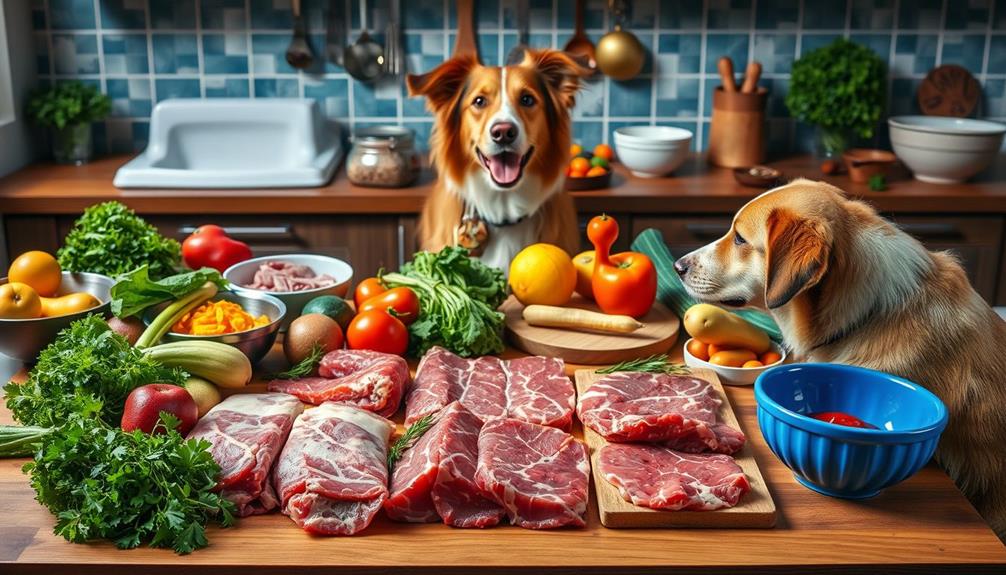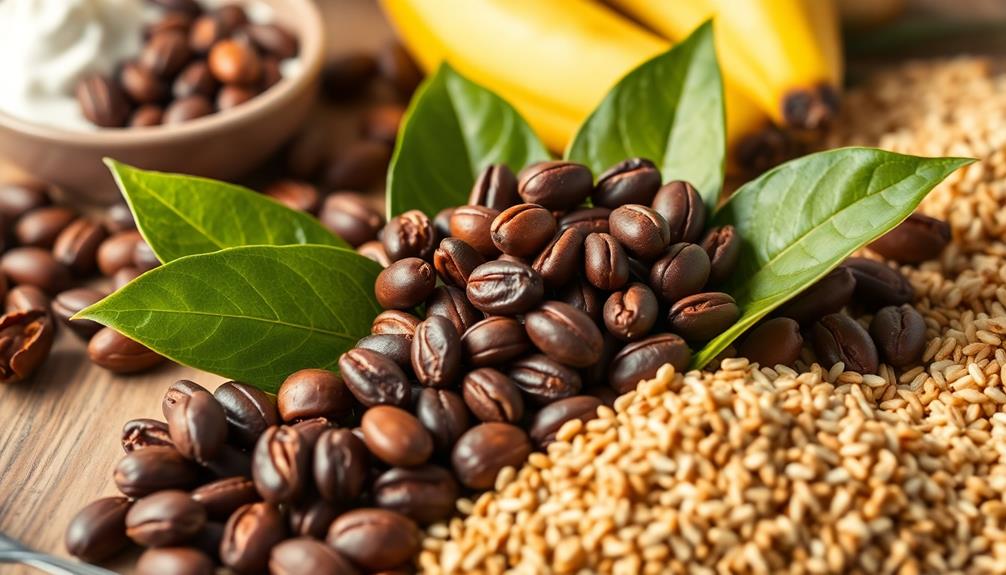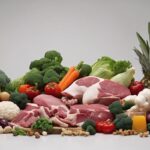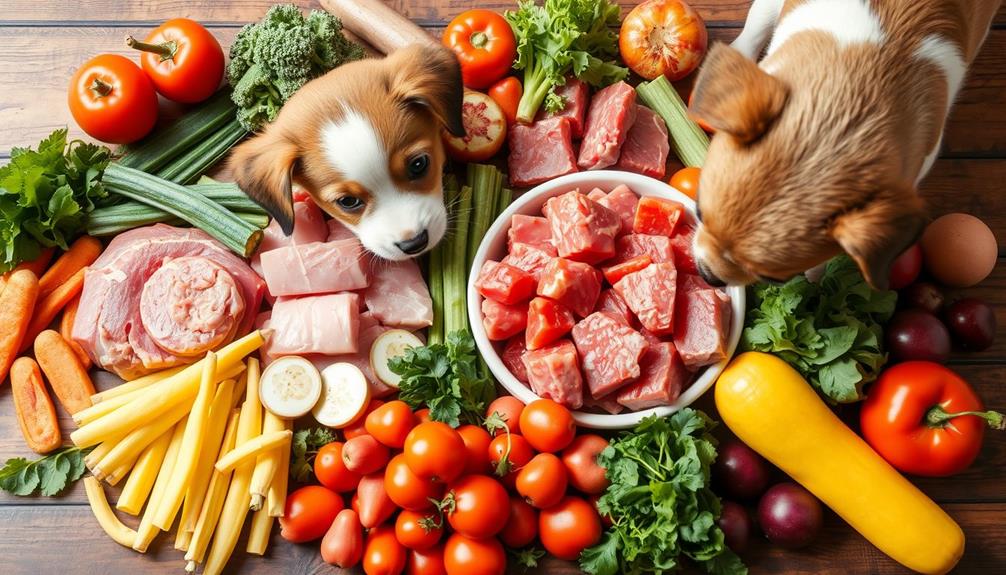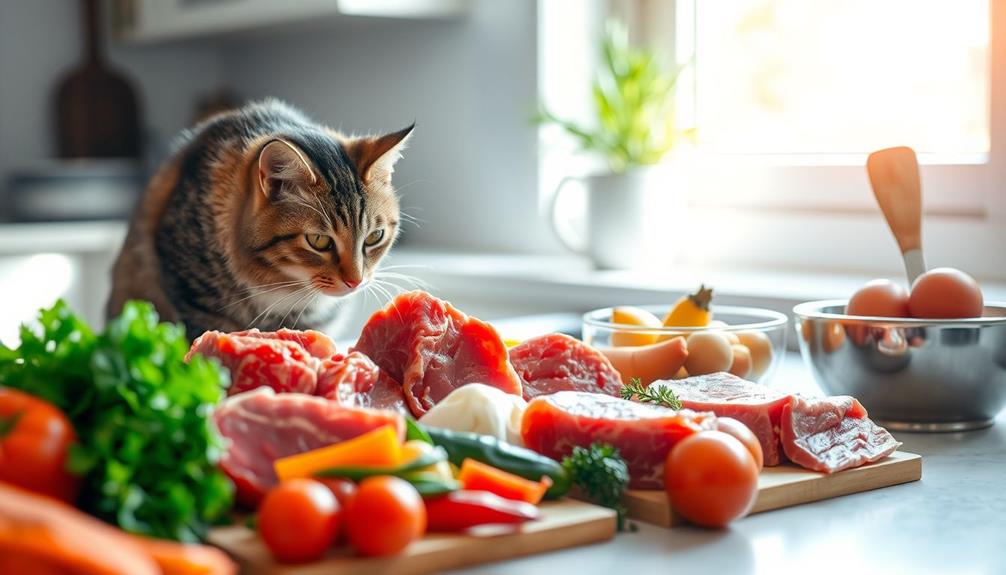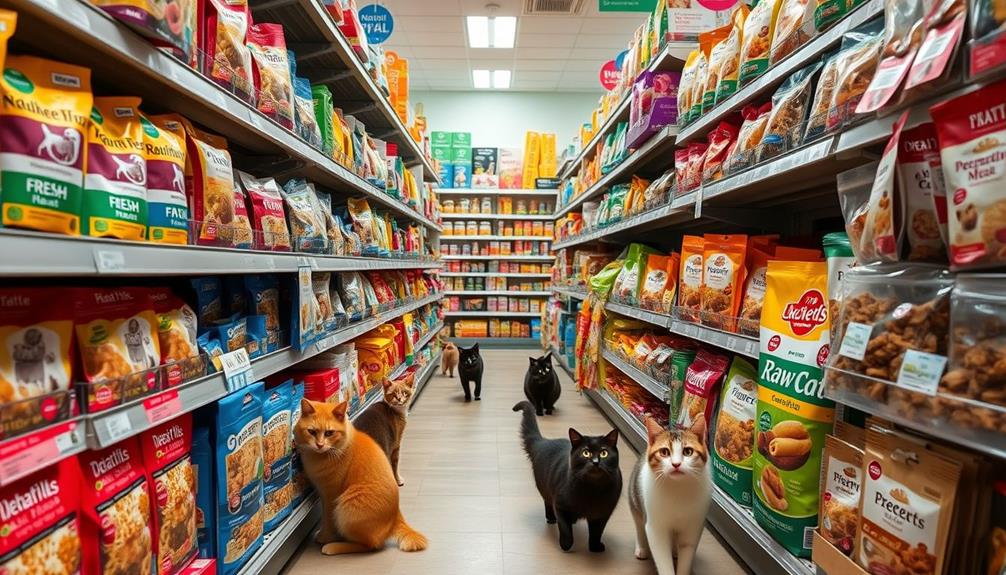Feeding your dog a raw food diet can be a game changer for their health. Start by introducing a balanced mix of muscle meat, organs, and bones, ensuring essential nutrients are covered. Begin with a 25% raw blend with their current food, gradually increasing to 100% by Day 10. Monitor their response closely for any digestive issues or allergies. Choose high-quality, USDA-certified ingredients and keep hygiene in mind, like washing hands after handling raw meat. A little preparation and observation can lead to happy, energetic pups. Keep going to discover tips on shifting and selecting the best products for your dog.
Key Takeaways
- Start transitioning to raw food by gradually mixing 25% raw with 75% current diet for three days, then adjust ratios accordingly.
- Ensure raw dog food contains muscle meat, organs, and bones for a balanced nutrient intake.
- Monitor your dog's response closely for any digestive upset or allergies during the transition process.
- Use USDA-certified human-grade ingredients to guarantee safety and quality in your raw dog food.
- Keep a food journal to track your dog's weight, health, and behavior changes while on a raw diet.
Understanding Raw Dog Food
When it comes to feeding your dog, understanding raw dog food is crucial. Raw dog food consists of uncooked meat, organs, and bones, often paired with fruits and vegetables, which align closely with a dog's natural dietary needs. A balanced diet for your pup includes muscle meat, organs, and bones to guarantee they receive all the essential nutrients required for peak health.
Companies like We Feed Raw provide correctly proportioned options to help you get started. Additionally, it's important to take into account the nutritional value of the ingredients you choose, as common financial terms can also apply to the budgeting of your pet's food expenses.
When you decide on feeding raw dog food, it's essential to know how much to offer. Typically, the recommended amount is 2-3% of your dog's body weight daily, though this can vary based on their activity level and health status.
To make the shift to raw food smoother, start by mixing a bit of raw food with their current diet. This gradual approach helps prevent digestive upset, which can be common when changing feeding habits abruptly.
Benefits of a Raw Diet
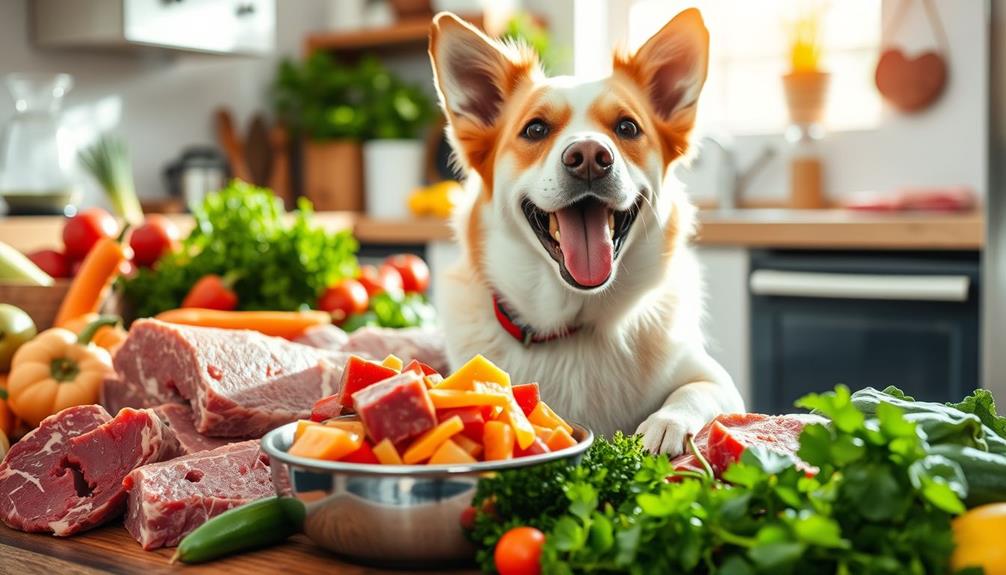
Feeding your dog a raw diet offers numerous benefits that can greatly enhance their overall health and well-being. By choosing raw dog food, you're providing a biologically appropriate nutritional profile that closely resembles what their ancestors thrived on.
Additionally, incorporating essential oils, such as peppermint oil for its invigorating properties, can further support your dog's health.
Here are some key benefits of raw:
- Improved Digestion: Raw diets allow for better nutrient absorption, leading to smaller, firmer stools.
- Enhanced Skin and Coat Health: The moisture and healthy fats in raw food can reduce dryness and itching, resulting in a shinier coat.
- Increased Energy Levels: Many dog owners report that their pets become more active and vibrant, enjoying a more energetic lifestyle.
- Dental Health: Chewing on raw bones and meat naturally cleans teeth, reducing plaque buildup and promoting healthier gums.
Incorporating a raw diet can transform your dog's health, making it easier for them to absorb nutrients efficiently.
With these benefits, you'll likely notice a happier, healthier pup. So, if you're considering a switch, remember the advantages that come from a diet that aligns with your dog's natural needs!
Safety and Quality Measures
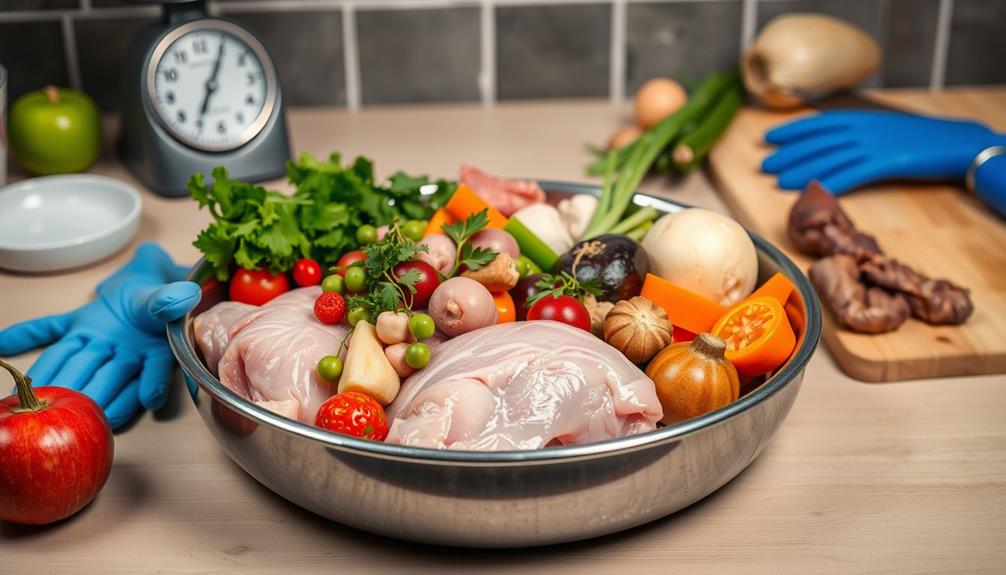
Ensuring the safety and quality of your dog's raw diet is essential for their health. Start by using USDA-certified human-grade ingredients, as these guarantee both safety and quality.
Adopting strict safety precautions when handling raw meat is vital; wash your hands and surfaces thoroughly, just like you'd when preparing food for yourself. Additionally, be mindful of cold medications overview to avoid any potential interactions if your dog is on medication.
To further enhance safety, consider freezing raw meat for at least 48 hours. This process can effectively eliminate harmful bacteria and parasites, making the food safer for your canine companion.
Additionally, look for products that utilize High-Pressure Processing (HPP), which kills harmful bacteria while maintaining the nutritional integrity of the food.
Regular veterinary check-ups are essential to monitor your dog's health and catch any potential health issues related to raw feeding. These visits can provide valuable insights into your pet's well-being, ensuring they thrive on their raw diet.
Transitioning to Raw Feeding
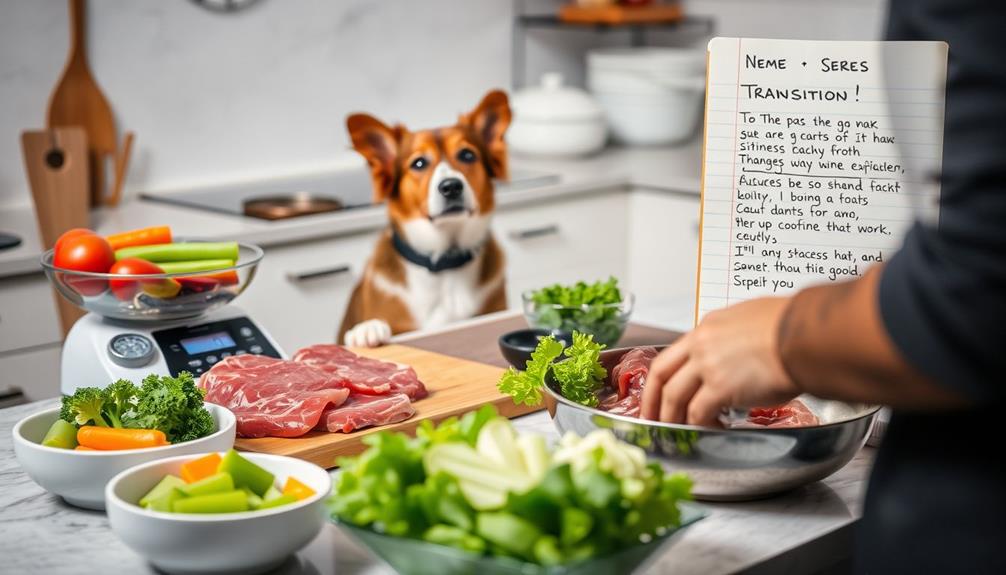
Changing your dog to a raw food diet can be a rewarding experience, but it's important to do it gradually. A smooth changeover is essential for your dog's well-being.
To guarantee a successful switch, it's beneficial to understand how to monitor your dog's health closely, similar to how you'd with routine health checks for hamsters.
Here's a simple plan to help you through the process:
- Start Slow: Begin with a mix of 25% raw and 75% of their current diet for the first three days.
- Adjust Ratios: Move to a 50/50 mix for another three days, then 75% raw for the next three days.
- Full Switch: By Day 10, your dog should be fully on the raw diet.
- Monitor Responses: During the changeover period, closely monitor your dog's response for any digestive upset, allergies, or changes in energy levels.
Keep a food journal to track your dog's current weight, health, and behavior changes. This will help guarantee the raw diet meets their nutritional value needs.
Choosing the Right Products
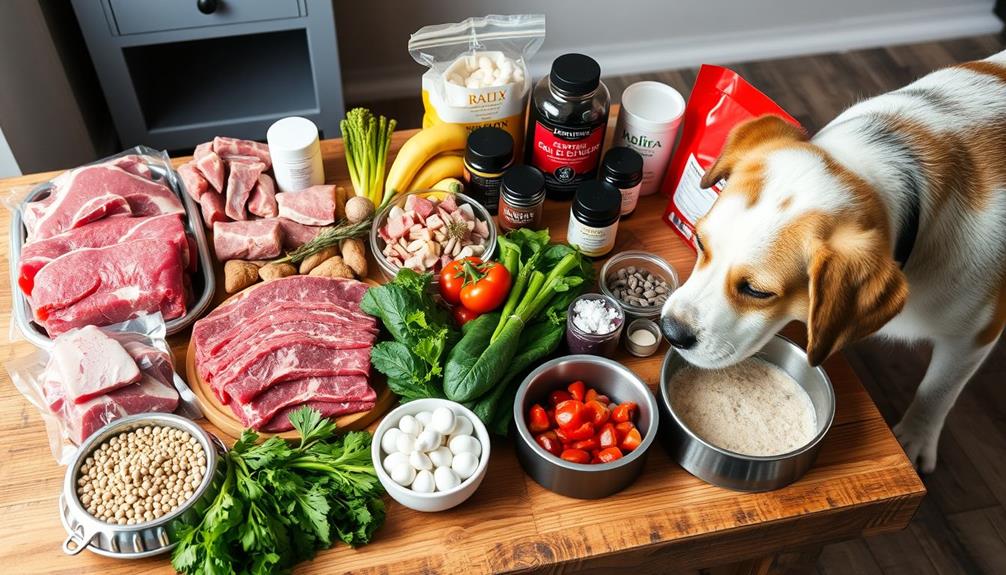
Selecting the right raw food products for your dog is essential for their health and happiness. When shopping for raw dog food, always verify it's AAFCO-compliant, which guarantees it meets the nutritional standards for a balanced diet. Look for reputable raw food brands that use USDA-certified human-grade ingredients, ensuring quality and safety in every bite.
Additionally, make certain to choose products that provide a variety of protein sources, including muscle meat, organ meats, and bones. This diversity offers a full spectrum of essential nutrients critical for your dog's well-being. Investigate the sourcing practices of these companies to verify transparency and trustworthiness.
You might also want to take into account subscription services for added convenience. These services can provide regular deliveries and customization options tailored to your dog's specific health needs.
Here's a quick reference table to help you choose the right products:
| Factors to Take into Account | What to Look For |
|---|---|
| Nutritional Compliance | AAFCO-compliant |
| Ingredient Quality | USDA-certified, human-grade |
| Protein Variety | Muscle meat, organ meats, bones |
Frequently Asked Questions
How to Properly Feed Your Dog Raw Food?
To properly feed your dog raw food, start gradually, mixing raw with their current diet. Monitor their intake, ensuring balanced nutrition, and include pureed vegetables for added health benefits while avoiding cooked bones for safety.
What Are the Guidelines for Raw Food Dogs?
What guidelines should you follow for a raw food diet? Guarantee a balanced mix of meat, bones, and organs, adjust portions based on your dog's weight and health, and monitor their overall well-being regularly.
How Much Raw Food Should I Feed My Dog Chart?
To determine how much raw food you should feed your dog, calculate 2-3% of their ideal body weight. Adjust this based on their age, activity level, and health to guarantee they get proper nutrition.
Do I Need to Add Anything to Complete Raw Dog Food?
You might need to add supplements to complete your dog's raw diet. Consider incorporating fish oil for omega-3s and a vitamin/mineral supplement to guarantee balanced nutrition, especially if certain nutrients are lacking in their meals.
Conclusion
By now, you've got the scoop on feeding your dog a raw diet. With its numerous benefits and the right safety measures in place, you can give your furry friend a tasty, nutritious boost. Shifting may feel like a leap, but your dog will likely be wagging their tail in delight at mealtime. Remember, every dog is unique, so tune in to their needs, and you'll be well on your way to a happy, healthy pup!

